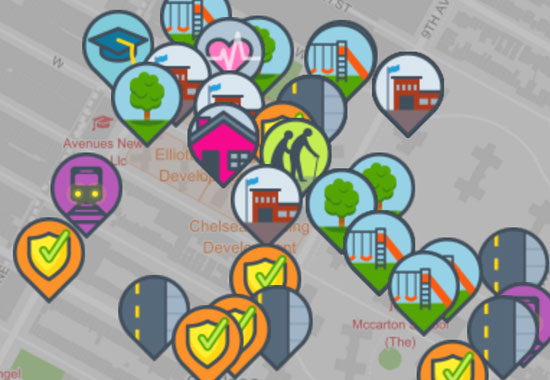EXECUTIVE SUMMARY
Introduction
This report proposes charging ride-hail companies (Lyft, Uber and Via) for the time their vehicles spend without a fare-paying passenger within the FHV Congestion Surcharge Zone — the area of Manhattan south of 96th Street. This charge on empty-vehicle time would incentivize the companies to reduce their stockpiling of vehicles in gridlocked Manhattan and nudge ride-hail customers toward less-congesting modes of travel. These outcomes would amplify the street-unclogging benefits of congestion pricing, improving travel efficiency and reliability in and around the Manhattan Central Business District (CBD).
This report was commissioned by the New York City Council and researched and written by transportation and traffic analyst Charles Komanoff (see Appendix for credentials). It was completed in March, 2020 but withheld from publication on account of the Covid-19 pandemic and ensuing lockdown. Release of the report was also impeded by the Trump administration’s prolonged holdup of the environmental review required to launch the congestion pricing program. (The report’s recommendations were premised upon congestion tolling of car and truck traffic into the CBD.)
Today, we publish the report essentially as written last March. The ascension of Joe Biden to the presidency is very likely to end the federal hold on congestion pricing. While it is true that the traffic patterns and transit usage assumed in the report have changed, the underlying facts and principles remain: equitably reducing the underpricing of motor vehicle traffic in and near the Manhattan core will measurably improve New York City’s economy, ecology and quality of life.
Problem Statement
The Taxi and Limousine Commission (TLC) estimated in 2019 that to complete a typical 20-minute fare trip in the Manhattan core, a ride-hail vehicle spends 8.3 minutes waiting for the pickup notification and 5.6 minutes traveling to the pickup. Because of the combined 13.9 minutes of unoccupied time, only about 60 percent of ride-hail vehicle time in the Manhattan core is spent conveying passengers; the other 40 percent is spent empty.
This is partly by design, as the ride-hail companies’ business model relies on rapid and reliable arrival at customers’ requested locations, which the companies facilitate by keeping a supply of empty vehicles at the ready. This stockpiling of vehicles enables customers to quickly secure a ride, but at a high cost: both the empty vehicle waiting for the next pick-up notification and the driver traveling to the passenger worsen congestion in Manhattan, slowing down everyone — from ride-hail customers themselves to taxicab users, motorists, truckers, service workers, bus riders, pedestrians and cyclists.
While it’s not possible to entirely eliminate ride-hail empty time, public policy can make a considerable dent in it. City government has the authority to incentivize the ride-hail companies to reduce both the number of vehicles they field in the Manhattan core and each vehicle’s average empty-time percentage. This report explores the rationale, outlines policy and engineering tools, and estimates the benefits of doing so.
Methodology
This report employs publicly available data and the author’s open-source New York City traffic model known as the Balanced Transportation Analyzer (BTA). Although the BTA was developed and has been most intensively used to model congestion pricing, it is also suited for analyzing congestion impacts and solutions concerning ride-hail vehicles.
Two features of the BTA model figure heavily in this report. One is its ability to estimate the average congestion causation — literally the time everyone loses because traffic is incrementally heavier — associated with one vehicle (or fleet of vehicles) taking up space in Manhattan’s Central Business District (CBD) as it travels to or waits for passengers. The other is the model’s capacity to calculate how ride-hail fares and thus usage are likely to change in response to both congestion pricing and potential charges on ride-hail vehicles’ empty time in the FHV Congestion Surcharge Zone; and, in turn, how these changes will affect congestion levels and travel speeds. (See “Manhattan Zones” box on p.15 for various pricing geographies.)
The first feature is valuable because it enables city policy makers to calibrate empty-time charges for ride- hail vehicles to the level of the congestion tolls recommended by experts which have been authorized by statute to go into effect in the near future. The second feature lets us predict with confidence the magnitude of the travel-speed benefits from implementing the empty-vehicle charge.
Key Findings
In 2019, the TLC adopted rules setting a cap on the per- cent of time that ride-hail vehicles may spend without a passenger within congested areas of Manhattan (“Cruising Cap”). These rules were set to take effect early last year but are tied up in litigation.
The TLC cruising cap does not apply to owners or operators of medallion taxicabs, whose numbers have been capped for years at 13,587 vehicles — effectively limiting the impact of taxi cruising on Manhattan traffic congestion. Similarly, this report’s recommendations to charge for empty ride-hail vehicle time would not apply to medallion taxis.
This report concludes that a policy charging the ride-hail companies 11 cents for each minute their vehicles are in the FHV Congestion Surcharge Zone (Manhattan south of 96th Street) without a passenger during peak hours (half that rate at other times) would be in sync with the pending congestion tolls on cars and trucks. Such a pol- icy would lift CBD travel speeds during those hours by 2.5 to 3 percent, in part by reducing the presence there of empty ride-hail vehicles by nearly 10 percent.
The empty-vehicle charge proposed in this report would replace, not supplement, the TLC’s proposed cap on the ride-hail vehicles’ cruising time. Charging the ride-hail companies for each minute of their affiliated vehicles’ empty time in the FHV Congestion Surcharge Zone (“Sur- charge Zone”) would outperform the Cruising Cap in the following ways:
- The projected boost in Manhattan travel speeds from the empty-vehicle charge, estimated to be 2.7 percent, would be nearly four times as great as the boost in speeds from the Cruising Cap (0.7 percent).
- The societal net benefits from reducing traffic gridlock and other congestion costs with the empty-time charge are estimated to be $160 million per year, far exceeding the estimated $40 million annual net benefit from the Cruising Cap.
- The empty-vehicle charge would provide the city with $80 million a year to improve travel times and ameliorate street conditions worsened by ride-hail vehicle stockpiling.
- The empty-vehicle charge on ride-hail vehicles can be digitally monitored and collected directly by the TLC.
- Time-based empty-vehicle charges for ride-hail vehicles could create a pathway to graduating New York State’s “one size fits all” lump-sum taxi and ride-hail vehicle congestion surcharges to a more efficient and equitable surcharge system based on each fare-trip’s time within the Surcharge Zone.
- Empty-vehicle charges for ride-hail vehicles in Manhattan could also serve as a template for regulating the proliferating delivery services that are overwhelming many New York neighborhoods.

